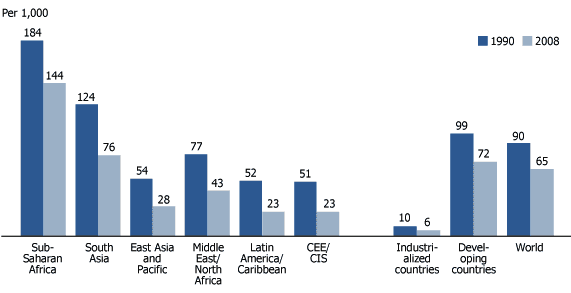Eric Zuehlke
Former Web Communications Manager

December 15, 2009
Former Web Communications Manager
(December 2009) Lack of access to quality health care and clean water and sanitation, undernutrition, and other preventable or treatable causes lead to the deaths of tens of thousands of children worldwide every day. But new data show that there has been significant progress in child survival and immunization coverage in developing countries. Since 1990, there has been a decline in the under-5 mortality rate in every region in the world. The number of children under age 5 dying every year, mostly from preventable causes, has declined 28 percent, from 90 deaths per 1,000 live births in 1990 to 65 per 1,000 live births in 2008. It is estimated that 10,000 fewer children under age 5 died every day in 2008 than in 1990.
New estimates from UNICEF, WHO, World Bank, and the UN Population Division show that under-5 mortality has declined steadily since 1990, and that progress has accelerated this decade. In 1990, nearly 13 million children died before their fifth birthday. By 2008, that number had been cut down to 9 million.1
Progress in under-5 mortality has been made in every region of the world, including some of the least developed countries. For example, Niger, Malawi, Mozambique, and Ethiopia reduced their under-5 mortality by more than 100 per 1,000 live births since 1990. Countries with high under-5 mortality such as Nepal, Bangladesh, Eritrea, Laos, Mongolia, and Bolivia have reduced mortality by 4.5 percent or more. Latin America and the Caribbean, Central and Eastern Europe, and the Commonwealth of Independent States have seen the greatest progress since 1990, with over a 50 percent reduction.2

Note: CEE and CIS are abbreviations for Central/Eastern Europe and Commonwealth of Independent States.
Source: www.childinfo.org.
Despite progress across the globe however, the geographic divergence of under-5 mortality continues, and parallels the prevalence of extreme poverty: All 34 countries with rates higher than 100 per 1,000 live births are in sub-Saharan Africa, with the exception of Afghanistan.
Increasing access to immunization in developing countries is a key reason for the decline in under-5 mortality. More infants are immunized than ever before. According to new data, 106 million were immunized in 2008.
In recent decades, development and delivery of vaccines for diseases affecting those in developing countries were often sidelined in favor of more profitable treatments that affect those in developed countries. However, over the past eight years, the global vaccine market has tripled to meet the growing demand. A major reason is the growth of manufacturers in developing countries, who are now meeting 86 percent of the global demand for vaccines that are needed among for diseases that affect the most vulnerable in developing countries: measles, whooping cough, tetanus and diphtheria. The Global Alliance for Vaccines and Immunization (GAVI) , a partnership between WHO, UNICEF, the World Bank, and the Bill & Melinda Gates Foundation has been instrumental in the increased immunization coverage through strengthening delivery systems and introducing underused vaccines such as hepatitis B and yellow fever.3
According to UNICEF, 120 vaccines are now available to protect against deadly diseases, a record number, due to increasing development of vaccines for diseases that affect people in the developing countries. Measles is an example of success. Deaths from measles, one of the top five diseases that account for half of all deaths to children under age 5 worldwide, fell by 74 percent between 2000 and 2007, largely due to increased vaccinations.4
New vaccines against pneumococcal pneumonia and rotaviral diarrhea provide much promise to build momentum towards fighting the effects of pneumonia and diarrhea, the two leading causes of death for children under age 5 worldwide.
Despite the progress made toward reducing child mortality and expanding access to immunizations, under-5 mortality is concentrated among poorer regions and countries; 93 percent of all under-5 deaths occur in Africa and Asia. Half of these deaths occur in five countries: India, Nigeria, Democratic Republic of Congo, Pakistan, and China. India and Nigeria alone account for almost one-third of all global under-5 deaths.5 Of the 67 countries with high mortality rates (defined as 40 or more deaths per 1,000 live births), only 10 are on track to meet Millennium Development Goal 4—a two-thirds reduction in the under-5 mortality rate between 1990 and 2015.
In developed countries, providing vaccines to infants and young children is widespread and common. Protection against deadly diseases such as tetanus, measles, and diphtheria that are now rare in developed countries is still out of reach for many children in developing countries. An estimated 24 million children and an estimated 20 percent of children born every year are still do not receive lifesaving vaccines.6 These children live in all types of environments—urban slums, rural villages, and areas affected by armed conflict. Poor health systems, logistical and infrastructural obstacles for vaccine delivery, lack of knowledge of vaccines, and funding shortfalls continue to plague efforts to reach every child in developing countries.
According to UNICEF, with additional funding of $1 billion per year, vaccines could be delivered to all children in the 72 poorest countries. To put this figure in perspective, overseas conflicts cost the United States $144 billion 2009 alone.7
Eric Zuehlke is an editor at the Population Reference Bureau.
